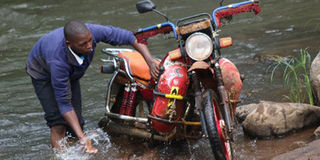Drug traces found in water sources

A cyclist washes his motorbike at Ruguti River in Chuka Igambang'ombe on June 24, 2016. Locals also use the water for domestic use. Twenty four pharmaceuticals used to treat HIV and malaria were found in rivers, waste and ground water. PHOTO | PHOEBE OKALL | NATION MEDIA GROUP
What you need to know:
- These drugs, measured in quantities of parts per billion or trillion, include nevirapine and zidovudine (for HIV treatment) and antibiotics like metronidazole, sulfamethoxazole and trimethoprim.
- Kisumu has higher concentrations of the antibiotic sulfadoxin, which is a combined drug with Fansidar that is used to treat malaria.
An array of antiretrovirals, antibiotics, hormones and anti-depressants have been found in water points in Nairobi and Kisumu.
Such drugs used to treat depression, fever and pain may pose danger because unlike most pollutants, they were made to act on the body.
In fact, 24 pharmaceuticals — the highest concentrations being antibiotics and ARVs — used to treat HIV and malaria were found in rivers, waste and ground water.
This is according to a study Occurrence Patterns of Pharmaceutical Residues in Waste Water, Surface Water and Ground Water of Nairobi and Kisumu, Kenya conducted by the University of Eldoret and Ghent University, Belgium.
The concentration of these prescription and over-the-counter medicines while minuscule — as they are far below the levels of a medical dose — are worrying scientists like Mr Kenneth K’oreje, one of the authors.
“People get drinking water from different sources, including rivers and boreholes, which can be contaminated. Those using such water are exposed to the drugs,” he told the Nation on Sunday.
“There is a 70 per cent chance that the surface and even treated water may still have traces of the drugs. In fact, some ARVs have resistant products that may be isolated in water long after treatment is done.”
Mr K’Oreje said due to exposure to antibiotics in the water, the bacteria becomes resistant and when someone ingests it, he or she runs the risk of getting the resistant strain.
These drugs, measured in quantities of parts per billion or trillion, include nevirapine and zidovudine (for HIV treatment) and antibiotics like metronidazole, sulfamethoxazole and trimethoprim.
Kisumu has higher concentrations of the antibiotic sulfadoxin, which is a combined drug with Fansidar that is used to treat malaria. When people take drugs, their bodies absorb some of the compounds and the rest are excreted.
HEALTH HAZARD
The waste water is then treated before it is discharged into rivers, reservoirs or lakes.
Pharmaceuticals can also be introduced into water sources through uncontrolled drug disposal (such as discarding medicines in toilets), livestock manure and improper waste disposals by drug manufacturing firms.
Some water is purified at treatment plants and piped to homes but drug residue can still be traced.
According to the seven-page study, treatment plants reduced by 35 to 80 per cent the pharmaceuticals in water but their effluent concentrations were up to 15 to 25 times higher than the Kenyan quality standards for effluent discharged into the environment.
Nairobi Water and Sewerage Company conveys sewer lines from people’s homes into stabilisation ponds at Ruai treatment plant where the water is held for 60 to 90 days. The solid is then decanted.
The effluent is released into Nairobi River and ends up in the Indian Ocean.
“We don’t have the expertise, instruments and knowledge to monitor these pharmaceuticals in water. It is something we need to think about,” the researcher said.
He added that while the trace of the drugs was not a cause for worry, the long term effects could be of concern.
“Studies show the occurrence of the drug compounds affect the ecosystem because fish and other aquatic species are endangered. It is just a matter of time when we too are,” he said.





